Friday, August 30, 2024
Tuesday, July 28, 2009
Multi-part/ multifunction travel board
This one is a two-part board in the same style as the last one I did with Spindrift.
There are a couple of differences though. First off, I made a 1.5" carbon fiber tube and rod for the center, to avoid having to mess with multiple rods and keeping them aligned. Secondly, I used some center boxes from probox as my milling stock to make my clamping units. This was a huge improvement from my previous units, both from a materials perspective and from a ease-of-production perspective since they already had a big center channel built into them.
Finally, and here's the development of which I'm most proud, the tail of the board has a removable section. With the removable tail section, I can use it as a 6'2" quad/tri, widepoint centered, or a 6'7" rounded pin bonzer5- widepoint 2.5" forward of center. Basically with this, I figure I'm pretty good in anything from knee-high to solid overhead.
I was definitely experimenting with the resin on the bottom lam. I've had some ideas about doing combinations of clears, tints and opaques over wood for a while... As you can see, the results were kind of a mixed bag. It's interesting, but not exactly what I expected.
6'2" N14.25 M21 T13.25 2.75"Thick
6'7" N14.25 M21 T16.25 2.75"Thick
The removable section is 5" long, so that makes the 6'2" have a centered widepoint, and the bonzer rounded pin has a widepoint 2.5" forward.

There are a couple of differences though. First off, I made a 1.5" carbon fiber tube and rod for the center, to avoid having to mess with multiple rods and keeping them aligned. Secondly, I used some center boxes from probox as my milling stock to make my clamping units. This was a huge improvement from my previous units, both from a materials perspective and from a ease-of-production perspective since they already had a big center channel built into them.
Finally, and here's the development of which I'm most proud, the tail of the board has a removable section. With the removable tail section, I can use it as a 6'2" quad/tri, widepoint centered, or a 6'7" rounded pin bonzer5- widepoint 2.5" forward of center. Basically with this, I figure I'm pretty good in anything from knee-high to solid overhead.
I was definitely experimenting with the resin on the bottom lam. I've had some ideas about doing combinations of clears, tints and opaques over wood for a while... As you can see, the results were kind of a mixed bag. It's interesting, but not exactly what I expected.
6'2" N14.25 M21 T13.25 2.75"Thick
6'7" N14.25 M21 T16.25 2.75"Thick
The removable section is 5" long, so that makes the 6'2" have a centered widepoint, and the bonzer rounded pin has a widepoint 2.5" forward.

Thursday, June 18, 2009
Westcoast Demo board
This thing is freakin' sweet! I made it to send out to the west coast as a demo. I'm on a couple of online message boards, and have always had a lot of interest in my boards from the SoCal crew, but folks don't want to pull the trigger on one of my boards without knowing how they ride. So, I figured what better way than to send one out to be demoed around by a couple of trusted people.
6'1.5"-20.25"-2.25"
Figured Anigre and European Beech veneers, carbon fiber rails, "secret sauce" metal-flake pinlines.

6'1.5"-20.25"-2.25"
Figured Anigre and European Beech veneers, carbon fiber rails, "secret sauce" metal-flake pinlines.

Two-piece travel board
This was another custom colaboration with Jeff. Interestingly, it was also a custom for the guy who got the bumblebee bonzer. Love those repeat customers!
This one is a more refined and developed version of the two-part travel board, with carbon-fiber rails. Shape by Jeff at Spindrift, tech by Jarrod. I made my own custom clamping system for this one, it gave me an excuse to buy that sweet little benchtop mill I've been wanting.

This one is a more refined and developed version of the two-part travel board, with carbon-fiber rails. Shape by Jeff at Spindrift, tech by Jarrod. I made my own custom clamping system for this one, it gave me an excuse to buy that sweet little benchtop mill I've been wanting.

bumblebee bonzer 6'7"
Man, have I ever gotten behind on my board updates here!
Ok, first up, this was a custom for a very cool guy up in the cold and dark Atlantic Northeast. It was also my first colaboration with Jeff from http://www.spindriftsurfboards.com/ on a custom order.
Sorry there's not more photos, don't know what happened there, I'll see if I can dig more up later.

Ok, first up, this was a custom for a very cool guy up in the cold and dark Atlantic Northeast. It was also my first colaboration with Jeff from http://www.spindriftsurfboards.com/ on a custom order.
Sorry there's not more photos, don't know what happened there, I'll see if I can dig more up later.
Friday, October 10, 2008
6'2" x 21 x 2 5/8" Quad Compsand
No clever name, just a quad fin setup on my favorite outline template.
Only thing really unique on this board is the rail, which was built out with a high-density foam called Divinycell instead of multiple layers of balsa. Much easier to work with, and it shaved probably two hours off of the build time on this one.


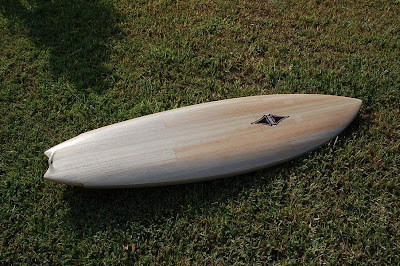


Only thing really unique on this board is the rail, which was built out with a high-density foam called Divinycell instead of multiple layers of balsa. Much easier to work with, and it shaved probably two hours off of the build time on this one.





El Caracol 5' 9.75" x 21" x 2.875"
Fun little experimental board.
EPS core, XPS rails covered with carbon fiber. Skins are Alder veneer with a deckpatch of balsa under the "traffic areas" to keep it from crushing under my heavy feet.
Shortest shape I've made for myself, but surprisingly functional. I took it out just to test it when we got the swell from hurricane Gustav. I fully expected that it would be to small and squirrelly for "real" waves, but I wound up riding it all day into solid overhead surf.




EPS core, XPS rails covered with carbon fiber. Skins are Alder veneer with a deckpatch of balsa under the "traffic areas" to keep it from crushing under my heavy feet.
Shortest shape I've made for myself, but surprisingly functional. I took it out just to test it when we got the swell from hurricane Gustav. I fully expected that it would be to small and squirrelly for "real" waves, but I wound up riding it all day into solid overhead surf.




Monday, July 07, 2008
Red boards are FASTER!
Wanted to try some different materials on this one... The initial impetus on this build was my buddy telling me I was a total tool for not riding any thrusters, or even owning one. So, hopefully this is versatile enough that if I hate it as a thruster I can do some other stuff with it. I was originally going to make something more conventional, but what would be the fun in that?
Same old 1lb eps core, but only 1/40" alder veneer for skins. The deck is supported from crushing by a balsa deckpatch under the veneer. Rails are one layer of balsa, with 1.5" of XPS foam (blue styro) outside of that.
Dims are 6'5" x 22 x 2 5/8 with a 1/4" deep concave in the deck. Bottom is mostly flat with a very mild single under the front foot. The huge center box is so I can play around with riding it as a single (didn't have a smaller, or black, box laying around), and the probox sides should give plenty of opportunity to mess with homemade fin sets.
The original plan was to tint it lightly red, and to let the blue rails show through to make the rails purplish. I kept adding pigment until I was happy with the color, and this is what came out. The grain of the wood is just barely visible, and the blue of the rails is entirely obscured.




Same old 1lb eps core, but only 1/40" alder veneer for skins. The deck is supported from crushing by a balsa deckpatch under the veneer. Rails are one layer of balsa, with 1.5" of XPS foam (blue styro) outside of that.
Dims are 6'5" x 22 x 2 5/8 with a 1/4" deep concave in the deck. Bottom is mostly flat with a very mild single under the front foot. The huge center box is so I can play around with riding it as a single (didn't have a smaller, or black, box laying around), and the probox sides should give plenty of opportunity to mess with homemade fin sets.
The original plan was to tint it lightly red, and to let the blue rails show through to make the rails purplish. I kept adding pigment until I was happy with the color, and this is what came out. The grain of the wood is just barely visible, and the blue of the rails is entirely obscured.




Wednesday, May 07, 2008
Cedar skin five-fin fish
5'11' x 22.5 x 2.625 with the Greg Griffin-style 5-fin setup in ply and carbon fiber. I tried to get with Greg to get a set of his fins, but we were having trouble connecting and I was frothing to get this thing finished. He was generous enough, however, to share the placements with me, and a friend forwarded me some tracings of the fin templates themselves, so I'm hoping I got pretty close to how the master himself would have done it.
I've surfed it a couple of times now, and it is definitely on the low end of the volume scale for me, but once up and going it is very drivey, as you would expect with 5 fins, but also very loose, which you wouldn't expect. I can't wait to get it into some good surf.


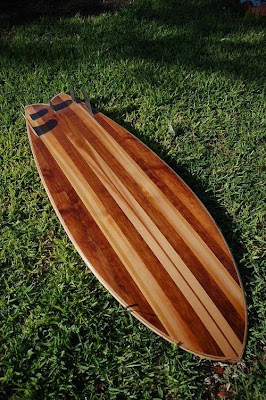

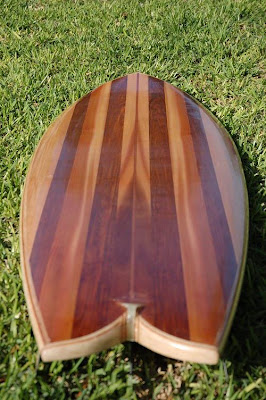
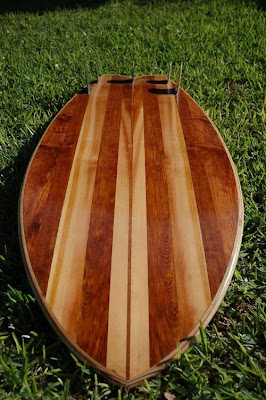

I've surfed it a couple of times now, and it is definitely on the low end of the volume scale for me, but once up and going it is very drivey, as you would expect with 5 fins, but also very loose, which you wouldn't expect. I can't wait to get it into some good surf.







Good call, lets see if you can ruin your new favorite board
I've had this idea in mind ever since deciding to take that bumblebee quad back. I figured I'd fix it up, and if it worked well for me I would make it into the ultimate travel board.
Let me preface this by saying that none of these ideas are my own. I simply adapted them to my needs, and improved them where I saw fit.
I didn't take many photos of the build process since my wife had the camera out of town when I was doing much of it, but I'll narrate best I can with the few cellphone pics I took.
I started by taking .5" ID carbon fiber tubing and glassing them into slots I routed into the board. I placed them close to the bottom skin and close to the rails so they'd have something to "grab" onto. The ends of the tubes were plugged with epoxy and the centers of the tubes were plugged with pencils wrapped with tape so the tube wouldn't splinter when the saw cut through it. The center tube was placed close to the deck, but the alignment didn't wind up being perfect with the other two, so it looks like I'll have to get by with just the two side tubes.
Here's a shot of the routered slots, the carbon fiber tubes before they went in, and the strips of balsa I used to cap the slots.
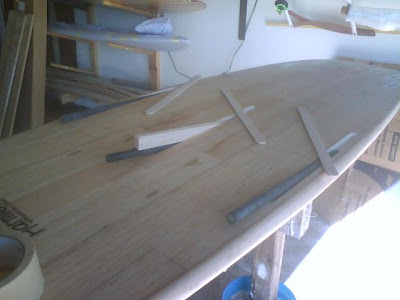
After putting the carefully aligned tubes into the board and re-capping the balsa and re-glassing, I made a jig to clamp on the board that would guide it down the sides of my table saw. Then I cut that sucker in half.
I totally borrowed the idea of placing the tubes before sawing from the Pope bisect, so don't give me any credit for that idea. I'm not an "idea guy", I'm more of a "planning and execution" guy.
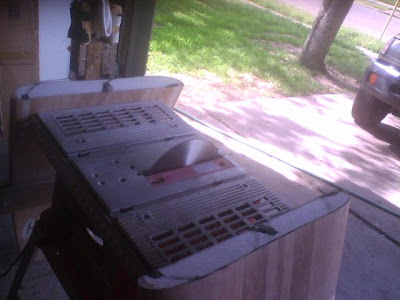 After that I cut up a longboard centerfin box and inlaid that into the foam so it was oriented vertically, and so each half of the board would have two sections of finbox that would face each other when the halves were mated up. should have taken a photo of this part, but when you see how it is bolted together you'll get it.
After that I cut up a longboard centerfin box and inlaid that into the foam so it was oriented vertically, and so each half of the board would have two sections of finbox that would face each other when the halves were mated up. should have taken a photo of this part, but when you see how it is bolted together you'll get it.
I used carbon fiber to tie the finbox sections to the deck skin, so they wouldn't come out under tension
then I put the half-circle abs plastic caps over the finboxes, and glassed over the exposed cut section, and lapped that over all the other work on the outside of the board. I had to tape down the glass to get it all lay down right in one pull.
then I put a thin sheet of ABS plastic on each half for a flat mating surface. Again, I can't take credit for this or the idea to use the finbox as a screw anchor, it was Pierre on Swaylocks who did this first, albeit without the CF tubes for rigidity.
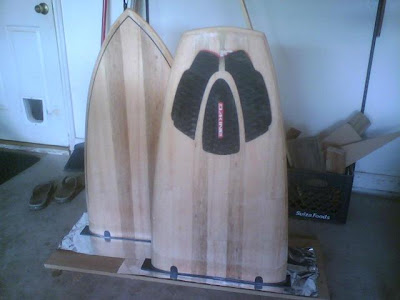
Here's the finished work.
The anchoring system, under the plastic caps are chunks of longboard center finbox facing each other so the bolt has something to anchor against. The aluminum bolt has holes through its head so it can be turned with a standard fcs-size allen wrench. Again, not my idea.

All the parts you need.
 Opened up so you can see the mating surfaces and the tube openings for the carbon fiber rods. You can also see the center tube which will remain empty because I didn't get it aligned right with the other two. If I were to do it again I would use a single large tube in the center, that way alignment isn't an issue.
Opened up so you can see the mating surfaces and the tube openings for the carbon fiber rods. You can also see the center tube which will remain empty because I didn't get it aligned right with the other two. If I were to do it again I would use a single large tube in the center, that way alignment isn't an issue.
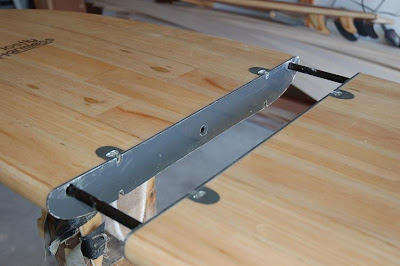
Assembled and ready to surf. Well, except for that patch on the tail... I couldn't knock this thing around my shop for a couple of weeks without dinging it, right?

I took it out in its new form for the first time yesterday, and I'm happy to report that I didn't manage to ruin it with this process. Thank goodness for that. All in all, it added about a pound of weight, but it was pretty light to begin with, so no worries on that.
Next step: Making a different tail half. If I can create a pintail section to mate with the existing nose, I'll essentially have two entire boards for a full range of surf conditions, and will only have to pack three short sections on surf trips. The ultimate travel board!
Let me preface this by saying that none of these ideas are my own. I simply adapted them to my needs, and improved them where I saw fit.
I didn't take many photos of the build process since my wife had the camera out of town when I was doing much of it, but I'll narrate best I can with the few cellphone pics I took.
I started by taking .5" ID carbon fiber tubing and glassing them into slots I routed into the board. I placed them close to the bottom skin and close to the rails so they'd have something to "grab" onto. The ends of the tubes were plugged with epoxy and the centers of the tubes were plugged with pencils wrapped with tape so the tube wouldn't splinter when the saw cut through it. The center tube was placed close to the deck, but the alignment didn't wind up being perfect with the other two, so it looks like I'll have to get by with just the two side tubes.
Here's a shot of the routered slots, the carbon fiber tubes before they went in, and the strips of balsa I used to cap the slots.

After putting the carefully aligned tubes into the board and re-capping the balsa and re-glassing, I made a jig to clamp on the board that would guide it down the sides of my table saw. Then I cut that sucker in half.
I totally borrowed the idea of placing the tubes before sawing from the Pope bisect, so don't give me any credit for that idea. I'm not an "idea guy", I'm more of a "planning and execution" guy.
 After that I cut up a longboard centerfin box and inlaid that into the foam so it was oriented vertically, and so each half of the board would have two sections of finbox that would face each other when the halves were mated up. should have taken a photo of this part, but when you see how it is bolted together you'll get it.
After that I cut up a longboard centerfin box and inlaid that into the foam so it was oriented vertically, and so each half of the board would have two sections of finbox that would face each other when the halves were mated up. should have taken a photo of this part, but when you see how it is bolted together you'll get it.I used carbon fiber to tie the finbox sections to the deck skin, so they wouldn't come out under tension
then I put the half-circle abs plastic caps over the finboxes, and glassed over the exposed cut section, and lapped that over all the other work on the outside of the board. I had to tape down the glass to get it all lay down right in one pull.
then I put a thin sheet of ABS plastic on each half for a flat mating surface. Again, I can't take credit for this or the idea to use the finbox as a screw anchor, it was Pierre on Swaylocks who did this first, albeit without the CF tubes for rigidity.

Here's the finished work.
The anchoring system, under the plastic caps are chunks of longboard center finbox facing each other so the bolt has something to anchor against. The aluminum bolt has holes through its head so it can be turned with a standard fcs-size allen wrench. Again, not my idea.

All the parts you need.
 Opened up so you can see the mating surfaces and the tube openings for the carbon fiber rods. You can also see the center tube which will remain empty because I didn't get it aligned right with the other two. If I were to do it again I would use a single large tube in the center, that way alignment isn't an issue.
Opened up so you can see the mating surfaces and the tube openings for the carbon fiber rods. You can also see the center tube which will remain empty because I didn't get it aligned right with the other two. If I were to do it again I would use a single large tube in the center, that way alignment isn't an issue.
Assembled and ready to surf. Well, except for that patch on the tail... I couldn't knock this thing around my shop for a couple of weeks without dinging it, right?

I took it out in its new form for the first time yesterday, and I'm happy to report that I didn't manage to ruin it with this process. Thank goodness for that. All in all, it added about a pound of weight, but it was pretty light to begin with, so no worries on that.
Next step: Making a different tail half. If I can create a pintail section to mate with the existing nose, I'll essentially have two entire boards for a full range of surf conditions, and will only have to pack three short sections on surf trips. The ultimate travel board!
Gentlemen, we can rebuild him. We have the technology.
I'm back, and back to work!
One of the nice things about these compsand boards is that they can be rebuilt when needed. While I was away, I was in touch with the guy who had gotten the Bumblebee Quad I had made in my first batch of compsands. It had sustained some damage in some collision mishaps, and had been repaired poorly, to say the least. It also had some performance limitations that he wasn't entirely happy with, so I took it back in trade on one of the classic fish I had made in the last batch. I'm happy to say he's very happy with the fish.
So, I had my work cut out for me when this board got back into my hands, but I figured it would be a good warm-up for getting back into shaping again.
The deck was badly damaged, so it had to be removed first.

Then the areas where the rail was damaged had to be replaced. Since the rails are built up in multiple layers of balsa, they have to be replaced in the same way. The stair-steps are so the joints are staggered so as not to create any weak points in the rail.

The biggest problem with the performance of the board was that it was, quite simply, over-rockered. Too much curve = maneuverable but slow board. The top part of the photo shows the original rocker and the bottom half shows the rocker as I re-set it when I vacuumed the skin back on. Much better, and reflective of the shaping experience I have gained in the time since I originally made this board.

The finished board with new skin and pinline. I have been riding this board almost exclusively since fixing it up, and it is my new favorite ride. Funny how that works out.
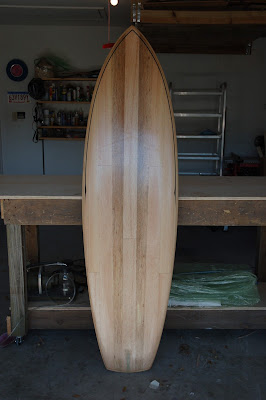
One of the nice things about these compsand boards is that they can be rebuilt when needed. While I was away, I was in touch with the guy who had gotten the Bumblebee Quad I had made in my first batch of compsands. It had sustained some damage in some collision mishaps, and had been repaired poorly, to say the least. It also had some performance limitations that he wasn't entirely happy with, so I took it back in trade on one of the classic fish I had made in the last batch. I'm happy to say he's very happy with the fish.
So, I had my work cut out for me when this board got back into my hands, but I figured it would be a good warm-up for getting back into shaping again.
The deck was badly damaged, so it had to be removed first.

Then the areas where the rail was damaged had to be replaced. Since the rails are built up in multiple layers of balsa, they have to be replaced in the same way. The stair-steps are so the joints are staggered so as not to create any weak points in the rail.

The biggest problem with the performance of the board was that it was, quite simply, over-rockered. Too much curve = maneuverable but slow board. The top part of the photo shows the original rocker and the bottom half shows the rocker as I re-set it when I vacuumed the skin back on. Much better, and reflective of the shaping experience I have gained in the time since I originally made this board.

The finished board with new skin and pinline. I have been riding this board almost exclusively since fixing it up, and it is my new favorite ride. Funny how that works out.

















